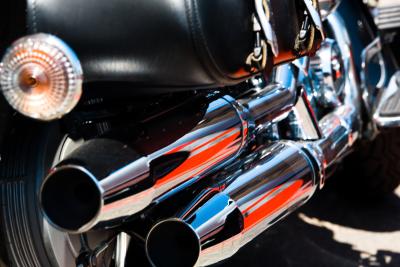
Header paint has been around seemingly as long as headers themselves. While paint technology has advanced quite a bit over the years, in this application at least, it's on the verge of being supplanted by something far superior. While ceramic coatings do generally cost twice as much as paint, the long- and short-term benefits reaped using them will almost always outweigh the initial investment.
Header paint differs from ceramic coating in a number of ways, not least of which in composition. Header paint consists of three parts: a pigment or color, a binder that holds the paint together and holds it to the metal, and a solvent that thins it. The "pigment" in header paint is usually a functional ceramic or carbon compound that adheres to the metal once the binder and solvent evaporate. Ceramic coating is actually a multi-part powder consisting primarily of ceramic and aluminum. A static electric charge allows the powder to stick to the header during application, after which it heads into a 1,000-plus degree oven. The tiny powder particles melt and fuse to each other and to the nearly red-hot header in a sort of "welding" process, permanently joining the two on a molecular level.
There's almost no comparison in durability between paint and ceramic coating. If you've ever tried to paint flexible rubber or plastic with cheap hardware-store spray paint, you've already got some idea of what happens to paint when the header heats up. Paint is far more brittle than metal, and it won't flex or expand when the metal header heats up and expands. After a few extreme heating and cooling cycles, the paint-to-metal bond will break and the paint will flake off. Ceramic coating is structurally similar to metal, and it can expand and contract at a similar rate without breaking its bond with the substrate. A header with a good ceramic coating job will probably outlive the engine its installed on, while paint is likely to flake off or at the very least suffer a degradation in appearance within a few thousand or even a few dozen miles.
Your basic header paint will withstand a sustained 800 degrees, with brief spikes to around 1,300 degrees; a basic ceramic coat will sustain 1,300 degrees, while advanced formulations can take upward of 2,000 to 2,500 degrees. But the big deal here isn't how much heat it can take, but rather what happens when it reaches that temperature. When paint hits its max temperature, it peels off of the header like dry paper. Ceramic coating will typically discolor and degrade somewhat, but it isn't likely to melt off for another 200 to 300 degrees. Bear in mind also that just reaching the coating's melting point doesn't mean that it'll just turn into water and fall off; ceramic coatings can take excursions to the melting point and recover, reform and re-fuse to the substrate metal.
Here be the death knell for paint. Even the best header paint provides minimal heat insulation, allowing all of that engine heat to radiate into the engine bay instead of staying in the header primary where it can help boost exhaust gas velocity and horsepower. While even a single outer-layer coating can provide significantly lower engine bay temperatures and higher EGVs, the ceramic coating's trump card is that it can be applied on both the inside and the outside of the tube. This double layer of protection can easily drop header surface temperatures by more than half, and it will prolong header life by keeping corrosive chemicals off of the metal.
Thermal insulation, on an engine dyno, is only worth about a 2 percent increase in horsepower and torque. But engine dyno cells aren't the real world, where heat trapped in the engine bay saturates the intake manifold, carburetor and cooling system. This heat saturation can have a dramatic effect on air density going into the engine, particularly if the car doesn't use a cold air intake. The basic rule of thumb is a 1 percent drop in horsepower for every 10-degree rise in intake air temperature, so simply lowering under-hood temperatures from 150 to 100 degrees can easily net a 5 percent gain in horsepower and torque in and of itself. If you've got a 400-horsepower engine, you may be looking at gains of upwards of 25 to 30 horsepower as installed in the vehicle.
Keeping heat in the exhaust where it belongs -- including the catalytic converter, if you choose to coat that -- has a couple of very interesting side effects. The first has to do with emissions. Trapping heat in the exhaust will get your catalytic converter to light-off temperature more quickly, which reduces emissions and may increase fuel economy depending on your computer programming. Higher temps will also allow you to run a larger, higher-flowing car without risk of dropping below the light-off temperature; another boon to power. And remember: hot air equals high-pressure air, and high-pressure air under your hood encourages front-end lift at high speeds. While no one's made any definitive claims that ceramic headers will make a car more stable at high speed, it is a distinct possibility.